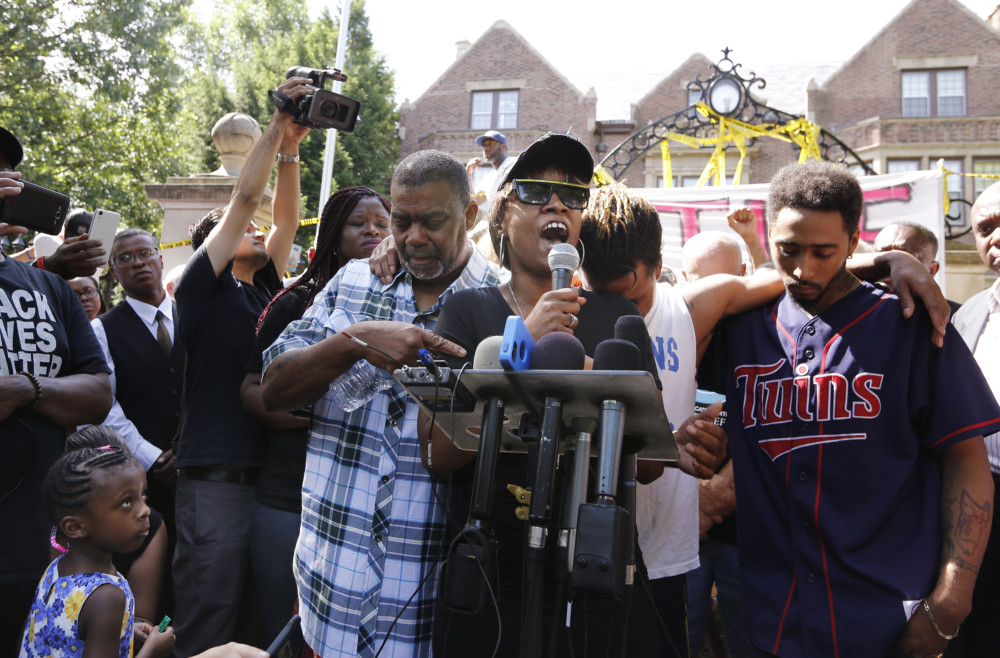By Julio Ojeda-Zapata
Pioneer Press, St. Paul, Minn.
WWR Article Summary (tl;dr) Citing the recent live stream video of the shooting in St. Paul, PR expert Cathy Hackl says issues will arise as to whether live video can be used in court as evidence, “But one thing is for sure: It gives citizens a chance to police those who should be taking care of them and hold them accountable. Live video is the ultimate watchdog.”
Pioneer Press, St. Paul, Minn.
The death of an African-American man at the hands of police officers on Tuesday in Louisiana was captured on video that later found its way onto the Internet. This was an all-too-familiar scenario.
But something altogether different and new occurred a day later during a similar situation, in Falcon Heights and not Louisiana, when, again, a black man was fatally shot by an officer.
Video of that incident — instead of being recorded, saved and subsequently uploaded — was streamed live onto the Web as events immediately following the shooting unfolded.
The live stream showed it all — a bloodied Philando Castile in a vehicle, his girlfriend Diamond Reynolds narrating with surreal composure, an officer’s gun framed in the car window, and so on — as it occurred and not in a time-delayed form.
It’s a crucial distinction, according to social-media experts and social-justice advocates, because this could possibly hold law-enforcement agencies, but also those they arrest, more accountable for their actions.
“If there is injustice happening, it can help highlight the injustice in a way that has not been possible before,” said Missy Voronyak, a Minneapolis-based social-media strategist employed at WCG, a San Francisco integrated communications agency.
The Castile live-stream “is an example of how powerful live video really is,” said Cathy Hackl, a former broadcast journalist turned public-relations and social-media operative.
“Many issues will arise as it pertains to whether live video can be used in court as evidence and if it should be controlled or not,” said Hackl, who has expertise in live streaming. “But one thing is for sure: It gives citizens a chance to police those who should be taking care of them and hold them accountable. Live video is the ultimate watchdog.”
Live-streamed footage will typically have more credibility than the conventional — and possibly edited — variety, said Jason Barnett, a St. Paul-based technology entrepreneur.
CHANGING THEIR CULTURE
Barnett said he believes police departments around the country are well aware of this and are having heated conversations about how to deal with it.
With regard to the court of public opinion, “Police need to change their culture,” Barnett said. “Even if there are reasonable excuses for particular incidents, they are going to be under a microscope. These types of images are going to get out even before the police chiefs are aware of them.”
And it goes beyond the oft-debated police-worn body cams that are intended to hold the officers — and the public they interact with — accountable. If an officer has acted properly in an enforcement situation, for example, the video can exonerate him or her from charges of wrongdoing.
From the law enforcement perspective, the jury is still out. FBI Director James Comey said in May in a New York Times report that while he could offer no statistical proof, he believed after speaking with a number of police officials that a “viral video effect” — with officers wary of confronting suspects for fear of ending up on a video — “could well be at the heart” of a spike in violent crime in some cities.
“There’s a perception that police are less likely to do the marginal additional policing that suppresses crime — the getting out of your car at 2 in the morning and saying to a group of guys, ‘Hey, what are you doing here?'” he said at the time.
Barnett also sees broad implications. “Having this (live-streaming) technology at everyone’s fingertips, ready to go at an instant, is going to change a lot of how we operate as a civil society,” he said. “It can lead to positive changes.”
Barnett is a live-streaming veteran. In 2008, when he led a St. Paul video-journalism nonprofit called the UpTake, he engaged in live-streaming experiments during sometimes-violent protests tied to the Republican National Convention in downtown St. Paul.
“We brought a lot of attention to events people didn’t know were going on,” Barnett said. “We were able to put an unfiltered view on things.”
Live-streaming tools were crude then, but have come a long way. They include Facebook Live, the service Reynolds used after her boyfriend got shot. Live video on Facebook, once accessible only to celebrities and journalists, is now available for use by all.
This led to “Chewbacca Mom,” the Texas woman who attracted a vast audience when she Facebook live-streamed herself playing with a battery-powered “Star Wars” Wookiee mask. The video is being called the most-watched on Facebook Live to date. Other live-streaming services include Meerkat and Twitter-owned Periscope.
Periscope achieved high visibility last month when Democratic members of the U.S. House of Representatives staged a sit-in over gun-control legislation, but Republicans cut the official video to the chamber. The protesters shifted to Periscope and Facebook Live streaming, which drew widespread attention and got rebroadcast on C-SPAN.
In a somewhat similar vein, Reynolds’ Falcon Heights live stream was a sort of 911 call, said Chuck Olsen, an UpTake veteran now leading a virtual-reality-video startup called Visual.
But in this case, the cry for help was aimed at the online masses, Olsen added.
“It was a citizen 911,” said Olsen, echoing a Wired article that makes the same point.
STREAMING VS. ARCHIVING
Reynold’s live stream could inspire others to use the same video-documentation method. Just a day later, Dallas resident Michael Kevin Bautista used Facebook Live to show police under fire in that city’s downtown during a sniper attack that would led to five officer fatalities.
“Holy s**t. Holy s**t,” Bautista said during the stream. “They’re shooting right now, and there’s an officer down. They’re moving in on somebody. I think they might have got somebody.”
Livestreaming, however, is not the only approach to using video as a means for keeping law enforcement accountable, according to Michelle Gross, president of a 16-year-old Minneapolis-based advocacy group called Citizens United Against Police Brutality.
Gross’ organization has long recommended the use of Bambuser, an app that automatically archives video online as it is recording, but doesn’t stream the video publicly as it does so.
This is important, Gross said, because not every video of a police officer is necessarily suitable for immediate public dissemination. At the same time, automated online archiving keeps the officers being recorded from confiscating the video, perhaps never to be seen again.
“It is absolutely legal to document and record police activity,” she said.
Reynolds’ Facebook Live stream came as a surprise to Gross.
“In 30 years of doing this kind of police-accountability work, it is the first time I can remember someone livestreaming,” she said. “I’ve never seen that before. It is extremely high-quality footage and it’s having a huge impact on the movement.”
But, Gross added, this approach is not necessarily better or more effective than using the Bambuser app.
“Both have merit,” she noted.
The use of live-streaming for social justice, though, is dependent on the service that is hosting the video feed.
FACEBOOK GETS FLACK
Those following the Castile situation Wednesday night found this out the hard way when Facebook pulled Reynolds’ video, and kept removing it when others tried re-uploading it. This triggered widespread outrage.
St. Paul resident Patrick Rhone, who is black, tweeted at the time: “Facebook not only removed the video but have also deactivated the young lady’s page. So. Angry!!! #FalconHeightsShooting”
Rhone added, “And, Facebook is deleting posts mentioning it. That’s it. I’m done with Facebook. I can’t be a part of a platform that erases our history.”
Bambuser makes no editorial judgments about video uploaded to its servers, Gross said.
Facebook, about an hour after pulling Reynolds’ video, reinstated it with a warning about graphic content. It claimed the temporary deletion was a result of a “technical glitch.”
Longtime Facebook observers, though, note the social network’s history of deleting first, if it deems possibly problematic content, and apologizing later (as it eventually did in this case).
Facebook founder Mark Zuckerberg later wrote in a post that the live-streamed images “shine a light on the fear that millions of members of our community live with every day.
“While I hope we never have to see another video like Diamond’s, it reminds us why coming together to build a more open and connected world is so important — and how far we still have to go,” Zuckerberg added.
The launch of Facebook Live earlier this year has brought new urgency to the question of how the site should approach moderation as tragedies unfold in real time.
Even before Reynolds’ video, Facebook was grappling with where to draw the line. For example, in June the site removed a live video made by a French Islamic State sympathizer who was shot after he killed a police officer and the officer’s romantic partner.
A day later, a video that appeared to depict the fatal shooting of a Chicago man was allowed to remain up, although with a graphic-content warning.
After the Chicago video, Facebook expanded the team that reviews live content, although it did not say how many people are now part of the team. The company said its workers use a variety of factors, including the number of user reports, number of viewers and type of reports, to determine which videos to review first.
It also plans to monitor some live broadcasts once they reach a certain popularity threshold and will take action — including interrupting the stream — if it sees a violation of its community standards.
“We do understand and recognize that there are unique challenges when it comes to content and safety for Live videos,” Facebook said in the statement. “It’s a serious responsibility, and we work hard to strike the right balance between enabling expression while providing a safe and respectful experience.”
Washington Post reports were used in this story.
















































































































































































































































































































































































